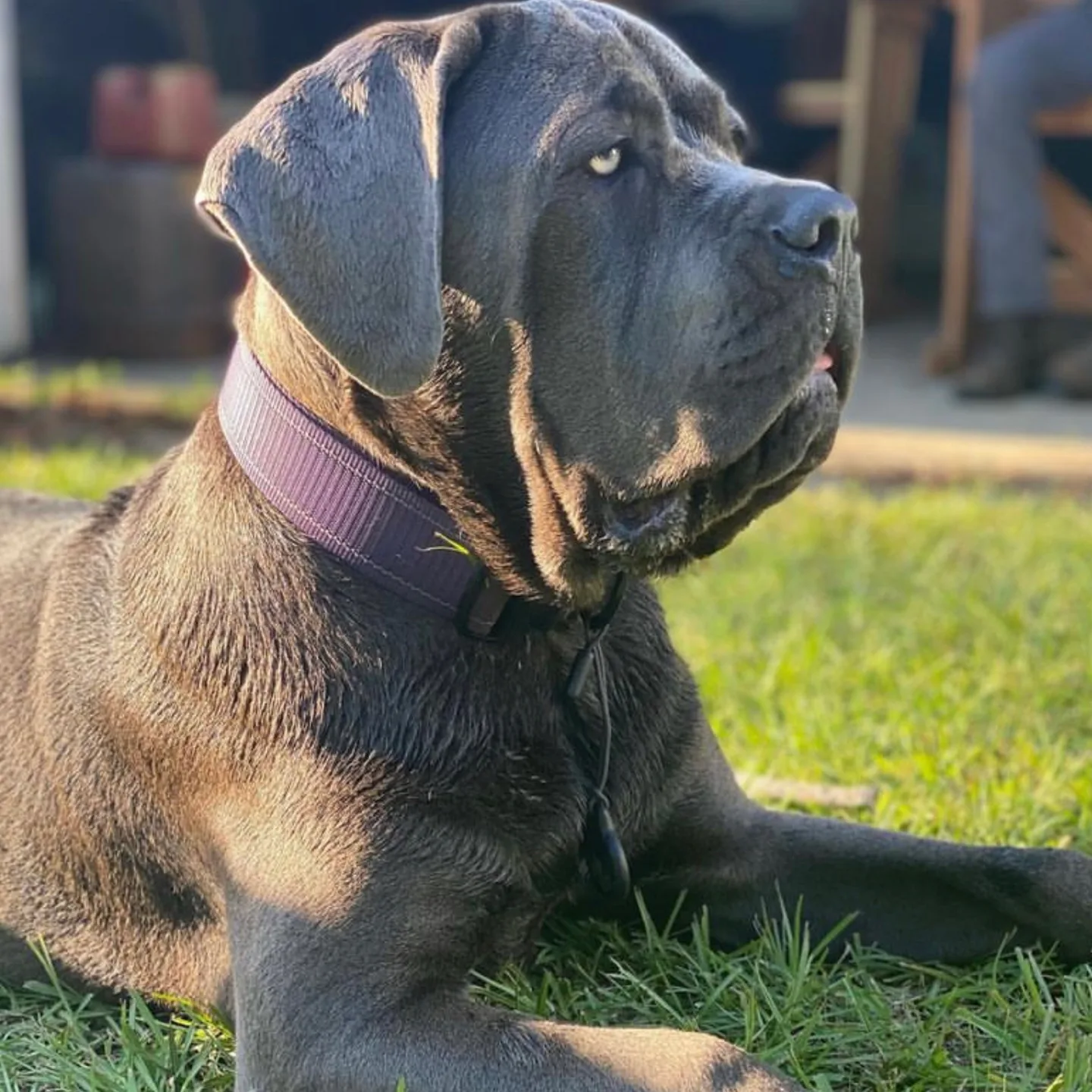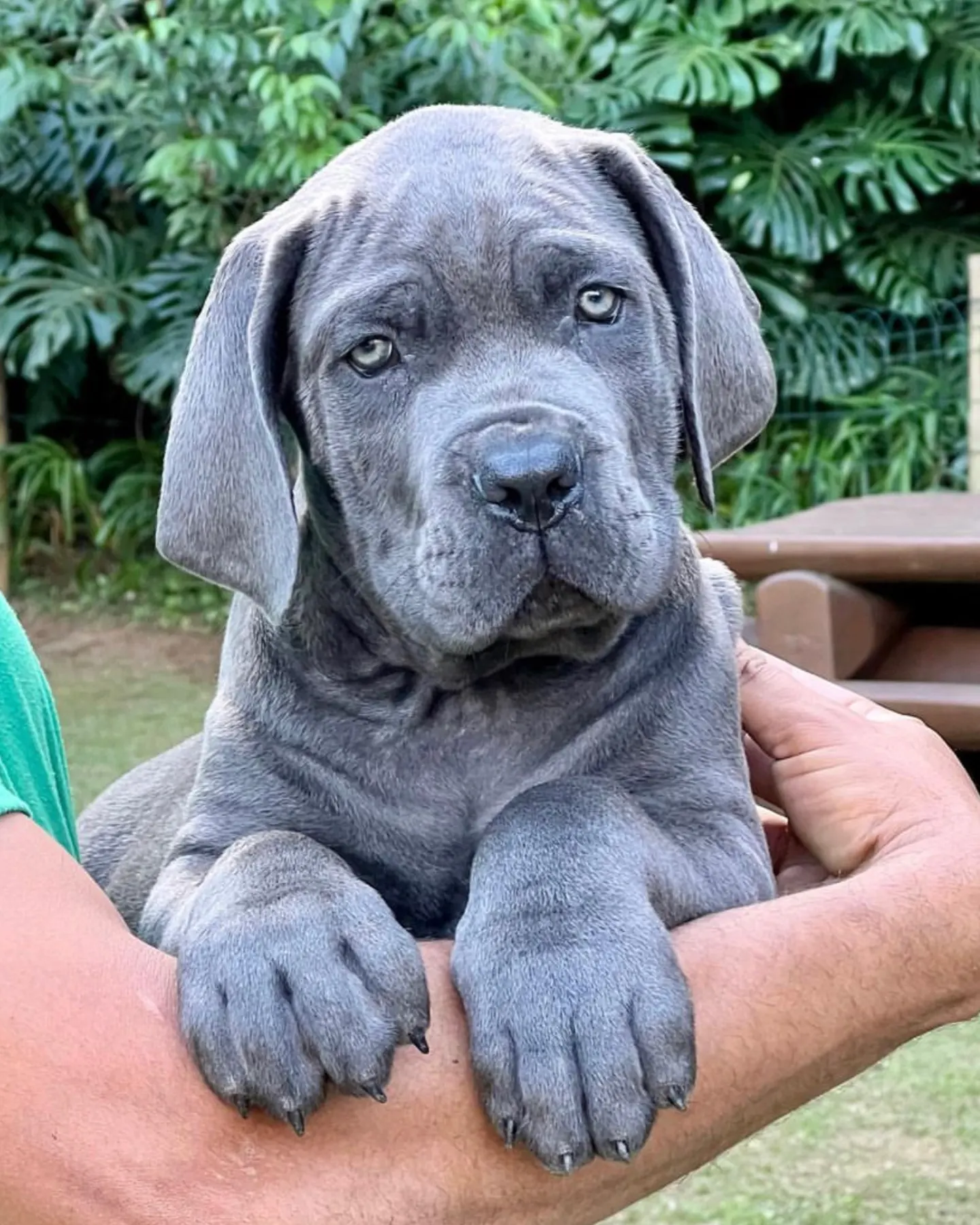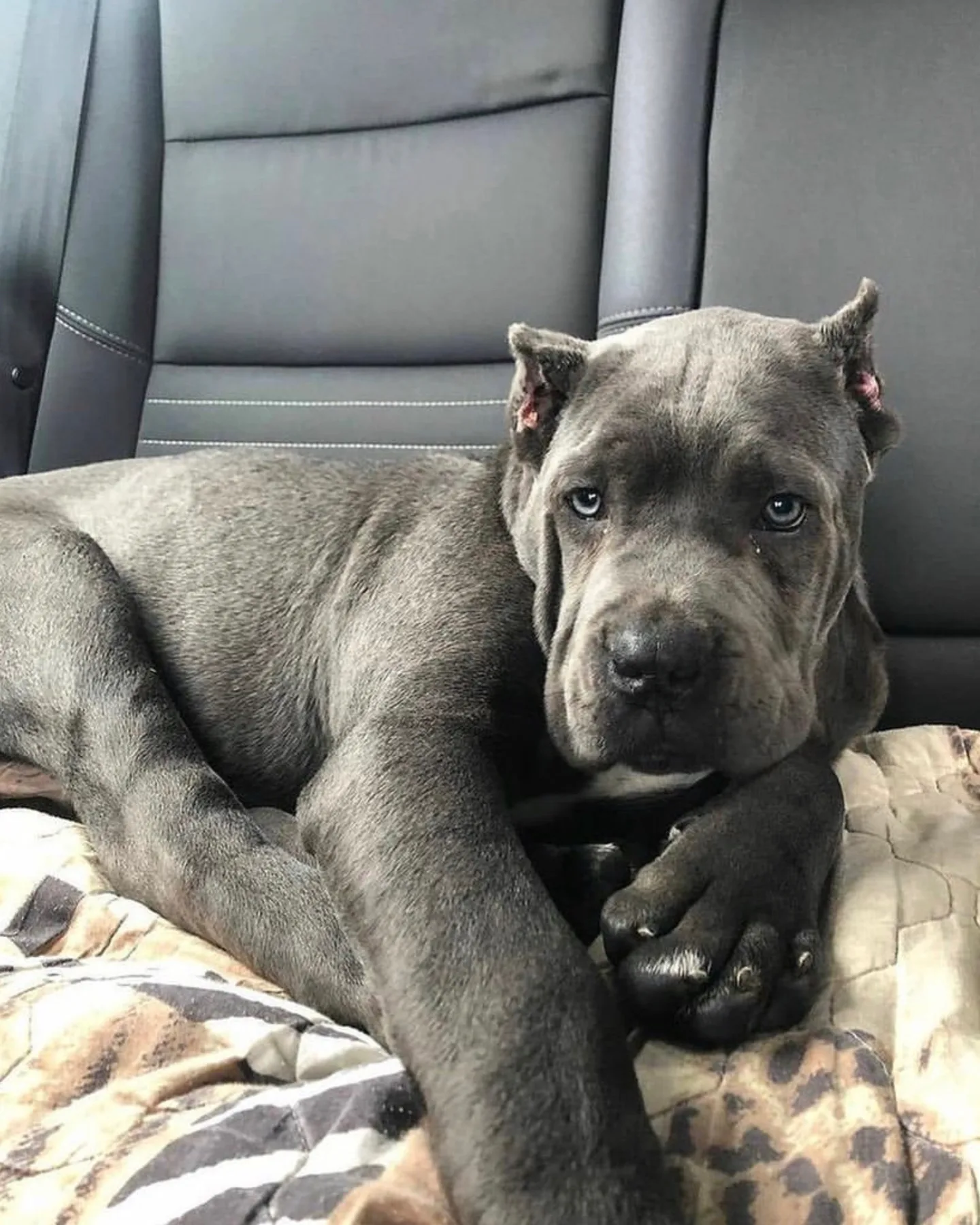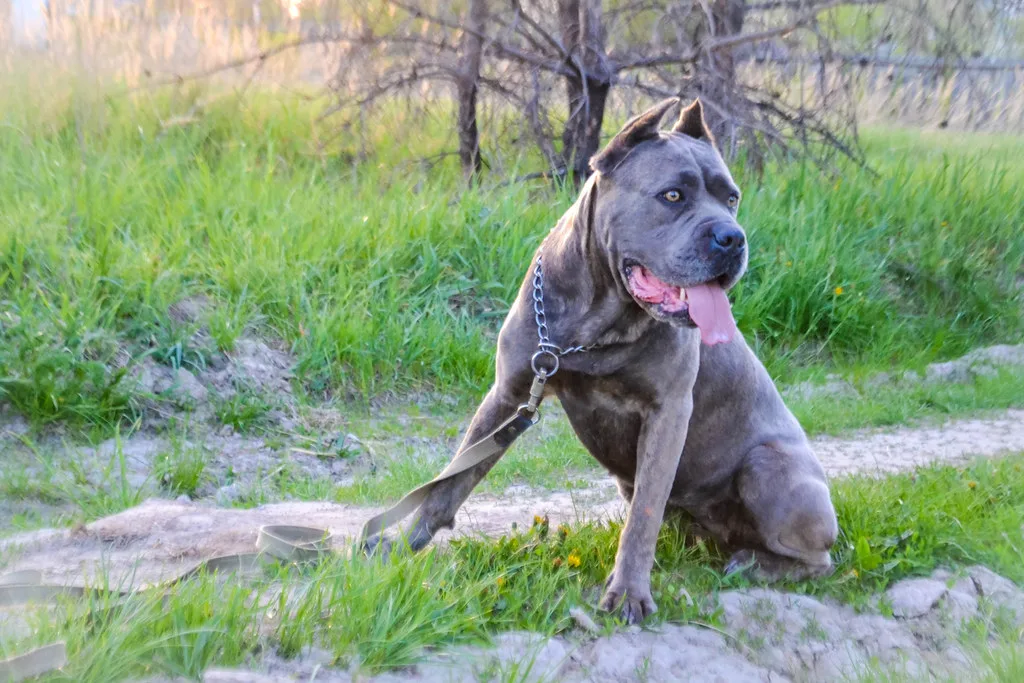Blue Cane Corsos are one of the most beautiful Cane Corso colors available out there. However, there is a lot of controversy surrounding these dogs. Their diluted, blue-greyish coat isn’t recognized by the Cane Corso breed standard, any many will discourage you from getting one. To be honest, in our opinion blue Cane Corsos are the same thing as gray Cane Corsos. Both of them have almost identical coat colors, but breeders love to use the term “blue” to make you think that their puppies are more exotic. It’s just a way to get some additional money by claiming these dogs are rare.
That’s why the blue Cane Corso has similar features to all other types of hues in the Cane Corso family. However, a recent study has shown that there is a difference in how long a Cane Corso lives depending on his coat color. That’s why we can’t help but wonder: How long do blue Cane Corsos live?
Do Cane Corsos have health issues?
With the right breeding and care, the Cane Corso is a very healthy breed, unlike some large dog breeds. The best breeders test Cane Corso pups for prevalent conditions like hip dysplasia, elbow abnormalities, and defects of the eyelids. Bloat, which is very typical in dogs with deeper chest cavities, is the main health concern with these dogs.
To keep their lean muscular frame, this energetic breed does require plenty of exercise and a healthy diet, but most owners feel that this is manageable with such a spirited dog. A Cane Corso will live longer if they are given regular walks, have access to lots of toys and human connections, and follow a healthy diet plan.
The most common health problems of Cane Corsos
Even though they are considered a generally healthy breed, Cani Corsi can still develop some health issues. Any of these conditions have the potential to cause a shorter lifespan. That’s why you as a dog owner have to care about two main things: buying your puppy from a reputable breeder and making sure your dog gets regular veterinary visits. By buying from a top breeder, you are lowering the risk of hereditary conditions. And with regular veterinary visits, you are making sure that even if your dog does get sick, he will get an early diagnosis. There is a significant difference between treating a well-developed disease, and an illness in its starting phase.

Source: Instagram (@custos_familiae)
Hip dysplasia
Hip dysplasia is the most common health problem in most dog breeds, and it doesn’t matter how big or small your dog is. It seems like they always have this disorder at least once in their lives. In hip dysplasia, the balls and sockets of the hip joint grow in an abnormal way, making them not fit into each other. Hip dysplasia can begin as early as 5 months of age. It can cause pain, stiffness, and walking problems in the back legs.
Ectropion and entropion
One of the most common eye problems in Cane Corsos is ectropion, which makes it hard for the eyelid to stay in place. In this syndrome, the lower eyelid rolls out or droops. It can happen to one or both eyelids at the same time. In some cases, it can cause damage to the eye’s cornea or nerves.
Your dog’s eyelids can also fold inward if he or she has a condition called entropion. The rubbing of the eyelids against the cornea caused by the inward rolling of the eyelids causes pain, corneal figments, conceal ulcers, perforations, and other dog eye problems.
Idiopathic epilepsy
Idiopathic epilepsy is a medical condition followed by a number of seizures. It is believed to be a genetic disorder, however, it can also be seen in pups with completely healthy parents. A seizure is an electrical disturbance in the brain that can’t be stopped. Because the brain isn’t working right, the level of consciousness, behavior, feelings, and movement change suddenly.
Bloat
The stomach is affected in two different ways by gastric torsion. The first way is through abdominal bloating, which happens when the stomach gets full of gas, foam, and liquids. The second way is torsion. Torsion is caused by gas in the stomach, which twists the stomach inside the abdomen. They may come one after the other or at the same time. This is a medical emergency, and it could end fatally in only a couple of hours. There are different ways to prevent it, such as surgery, or giving your dog smaller, more frequent meals.
How long do blue Cane Corsos live?
The average lifespan of a blue Cane Corso is between 9 to 11 years.
As you will see later on, this is slightly shorter than the lifespan of other colored Cani Corsi. As beautiful as the diluted coat color of these dogs is, recent statistical data showed that dogs with this coat do live shorter than darker Cani Corsi. It was not yet confirmed why this is the case, but still they can be a great family dog.
How long do Cane Corsos usually live?
When compared to other breeds, the Cane Corso has a relatively short lifespan of 10 to 12 years on average. Cane Corsos live less time than dogs of lesser sizes, like Chihuahuas, because of their huge size. Large-sized dogs age more quickly and are more likely to experience certain health problems.
However, some owners claim that the average lifespan of Cane Corsos can be significantly longer if you provide them with a healthy lifestyle and enough physical and mental stimulation. The lifestyle, diet, training, and appropriate medical care of dogs are just a few of the many variables that affect their lifespan. I believe that diet and nutrition play the biggest role in determining how long a Cane Corso lives.
We will talk later a bit more about all of the different factors that affect how long your dog will live. But before anything else, you have to make sure that you buy your Cane Corso puppy from a reputable breeder. Only reputable and good breeders do the health tests and screenings that are needed to make sure your future puppy is as healthy as it gets.

Source: Instagram (@tcane_corso)
Which color Cane Corso lives the longest?
Surprisingly, one of the many things that determine the lifespan of your Cane Corso is the color of his coat. According to a 2017 study, the average lifespan of 232 Cane Corso dogs from 25 different nations was 9.3 years, with variations depending on the coat color. Black dogs lived the longest (10.3 years), then brindle dogs (10.1 years), grey brindle dogs (9.8 years), fawn dogs (9.0 years), black brindle dogs (9.0 years), grey dogs (9.0 years), and other color dogs (8.1 years).
However, as you can tell, this is a relatively small study. Yes, the results were quite interesting and give us a better insight in how genetics and coat color do have an effect on the health of a pup, but that doesn’t mean that you shouldn’t buy a blue Cane Corso just because he isn’t on top of this list. After all, there are many other things that you should do to make sure your pet lives as long as possible.
What is the longest a Cane Corso has lived?
It’s pretty much impossible to answer this question. Cani Corsi are have been around for many, many years. In addition to that, they are popular all over the world, and not just in the United States. There is no data available to exactly tell how long the oldest Cane Corso has lived. However, upon my investigation on the internet, I saw many individual owners saying that their Corsos lived for 15 or 16 years. Which definitely is longer than the average lifespan.
What factors determine the Cane Corso lifespan
As we have already explained, there are different factors that will have a say in how long your Cane Corso lives. We already explained that hair color is one of them, and it does not really favor blue Cane Corsos. However, that doesn’t mean that there aren’t other aspects of your dog’s life that have an effect on its lifespan that you do have control over. So let’s see what factors determine the Cane Corso lifespan.
Diet and exercise
The main elements that affect a Cane Corso’s lifespan are diet and exercise. A dog’s life expectancy is increased by regular physical activity and exercise, which also keeps it healthy and fit. Without exercise, a dog may easily gain weight which can cause a number of different health problems.
We are what we eat, and we are as healthy as our diet is. It’s not that different for dogs. According to statistical analysis, dogs fed homemade raw food live an average of 13 years, compared to 10.4 years for dogs fed commercially produced food. Your Cane Corso will thrive on homemade food. But if you don’t have time to cook for him, make sure you buy premium kibble for large-sized breeds.
Regular veterinary visits
Prevention is the best treatment, and you can’t prevent any diseases in your dog if you don’t take him to the vet at all. The length of time your dog lives depends on the medical treatment you provide for it. Any problem that is detected and treated early enough will not only spare your Cane Corso from suffering but will also lengthen its life.
Family Background
By looking into or learning about the Cane Corso’s family history from the breeder who bred it, you can establish the breed’s average lifespan. Every breed’s appropriate history is often kept up to date by reputable breeders. Ask the breeder for details about the puppy’s family health history. Puppies with a higher-than-normal likelihood of developing common illnesses like cancer can be identified by looking at their family’s medical history.

Source: Instagram (@canecorsodone)
FAQ
What 2 breeds make a Cane Corso?
The Cane Corso belongs to the group of canine breeds known as Mollosers. As early as 1137 A.D., the ancient Green Molossi tribe began breeding these big guard dogs that resembled mastiffs. Some of these dogs were brought back to Italy during the Roman invasion of the Greek islands, where they were crossed with local Italian dog varieties. The Cane Corso and its larger relative, the Neapolitan Mastiff, were the two breeds that emerged.
How can you tell a real Cane Corso?
Consider the dog’s size, weight, and general appearance as a starting point. The dog should weigh no more than 100 pounds, and its shoulder height should not exceed 27 inches. Then, look at the dog’s head broadly. Rather than having a parallel skull and muzzle plates, Cane Corsi typically have larger heads with somewhat convergent plates. Additionally useful is a look at the dog’s tail. A Cane Corso’s tail often tapers little at the tip and is thick at the root. When at rest, the tail of a Cane Corso should be held low, horizontal, or just slightly higher than the back.
Will my Cane Corso’s eyes stay blue?
Cane Corsos only have blue eyes as Cane Corso puppies, and as they age, the color starts to fade. After three or four weeks, the color changes. Brown and gray are the most prevalent eye hues, and the color of their eyes is mostly dictated by the shade of their coats. Due to low levels of melanin production in their bodies, baby Canes initially exhibit blue tones in their eyes. However, the change in eye color may take longer if your puppy produces less melanin than normal.
What are Cane Corsos known for?
The Cane Corso is the most Googled dog breed in 12 different nations, including all of Europe. The Cane Corso is currently the 40th most popular dog breed in the United States according to the American Kennel Club. They have massive, strong bones and a lot of muscle. These dogs are referred to as “majestic” by many fans of the breed, including the American Kennel Club. They are frequently characterized by the power they possess. It’s not surprising that Cane Corsos are intelligent, cunning, and bred to hunt given their ancestry as Roman Canis Pugnaces. All of these amazing characteristics make them attractive in the eyes of people looking for large and powerful canines.

